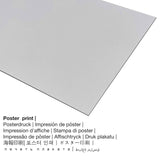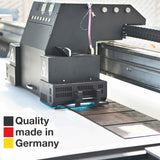Jean-Etienne Liotard, 1756 - Portrait of Maria Frederike van Reede-Athlone at Seven - fine art print
Taxes incluses. Frais de port calculés au paiement.
Portrait of Maria Frederike van Reede-Athlone at Seven painted by the Swiss painter Jean-Etienne Liotard as your own artprint
The more than 260 year old artwork was painted by the Swiss artist Jean-Etienne Liotard in 1756. Besides, this artwork is included in the digital collection of The J. Paul Getty Museum. With courtesy of The J. Paul Getty Museum (public domain license).The creditline of the artwork is the following: . Besides this, the alignment of the digital reproduction is portrait and has a ratio of 1 : 1.2, which means that the length is 20% shorter than the width.
Select your product material
For every fine art print we offer different sizes & materials. In order match your personal requirements perfectly, you can choose among the following product customization options:
- Glossy acrylic glass print: The acrylic glass print, which is sometimes referred to as a plexiglass print, will transform your favorite artwork into décor. The great upside of a plexiglass print is that contrasts and color details become recognizeable with the help of the subtle tonal gradation in the print. The real glass coating protects your chosen art print against light and heat for many years to come.
- Printed poster (canvas material): The poster print is a printed flat canvas with a granular finish on the surface. It is used for putting your art print with the help of a special frame. Please note, that depending on the absolute size of the canvas poster print we add a white margin of approximately 2 - 6cm round about the artwork to facilitate the framing.
- Canvas print: The canvas print, which shall not be confused with a real artwork painted on a canvas, is a digital image printed on an industrial printer. A canvas has a distinctive look of three dimensionality. Canvas prints are relatively low in weight, which implies that it is easy and straightforward to hang your Canvas print without additional wall-mounts. Canvas prints are suitable for any kind of wall.
- Aluminium dibond print: An Aluminium Dibond print is a print material with a true effect of depth, which makes a fashionable look throuch a surface structure, which is non-reflective. The Aluminium Dibond Print is your ideal introduction to reproductions with aluminum. For our Direct Aluminium Dibond print, we print your chosen artpiece on the surface of the aluminum. The white & bright parts of the original artpiece shine with a silk gloss but without the glow. Colors are luminous, the details of the print are clear and crisp.
Important information: We try everythig possible to depict the art products as accurately as possible and to display them visually in our shop. Although, the colors of the print products, as well as the imprint might differ somehwat from the presentation on the device's monitor. Depending on the screen settings and the nature of the surface, not all colors are printed 100% realistically. Considering that all the fine art prints are processed and printed by hand, there may as well be slight variations in the exact position and the size of the motif.
Product table
| Print categorization: | art copy |
| Reproduction: | digital reproduction |
| Production method: | UV print / digital printing |
| Product Origin: | produced in Germany |
| Stock type: | on demand |
| Intended usage: | wall art, wall gallery |
| Alignment of the image: | portrait alignment |
| Side ratio: | 1 : 1.2 |
| Meaning: | the length is 20% shorter than the width |
| Materials available: | metal print (aluminium dibond), canvas print, acrylic glass print (with real glass coating), poster print (canvas paper) |
| Canvas print (canvas on stretcher frame) options: | 50x60cm - 20x24", 100x120cm - 39x47", 150x180cm - 59x71" |
| Acrylic glass print (with real glass coating) size options: | 50x60cm - 20x24", 100x120cm - 39x47" |
| Poster print (canvas paper) options: | 50x60cm - 20x24", 100x120cm - 39x47" |
| Aluminium print variants: | 50x60cm - 20x24", 100x120cm - 39x47" |
| Art print framing: | not available |
Background data on the original piece of art
| Artpiece title: | "Portrait of Maria Frederike van Reede-Athlone at Seven" |
| Artwork categorization: | painting |
| Generic term: | classic art |
| Artwork century: | 18th century |
| Artpiece year: | 1756 |
| Age of artwork: | around 260 years old |
| Museum / location: | The J. Paul Getty Museum |
| Location of the museum: | Los Angeles, California, United States of America |
| Website of the museum: | The J. Paul Getty Museum |
| License type: | public domain |
| Courtesy of: | The J. Paul Getty Museum |
Artist summary table
| Artist: | Jean-Etienne Liotard |
| Other artist names: | Jean-Étienne Liotard, Liotard, Liotard Jean-Étienne, Liotard Giovanni Stefano, Jean Etienne Liotard, jean etienne liotart, j. liotard, Liotard Jean Étienne, j. e. liotard, liotard j. e., Liotard John Stephen, etienne liotard, Leotard, Léodard, Liotard Jean-É., jan etienne liotard |
| Gender of the artist: | male |
| Nationality of artist: | Swiss |
| Professions: | painter |
| Country of the artist: | Switzerland |
| Classification of the artist: | old master |
| Lifespan: | 97 years |
| Born in the year: | 1692 |
| Birthplace: | Geneva, Geneve, Switzerland |
| Year died: | 1789 |
© Copyright of | Artprinta.com (Artprinta)
Original artwork specifications from the museum's website (© - The J. Paul Getty Museum - www.getty.edu)
Changing attitudes towards children and the emergence of a large middle class in eighteenth-century Europe increased the demand for portraits of children such as this one. Maria Frederike, the seven-year-old daughter of an aristocratic Dutch family, looks off to the side in a three-quarter view. Lost in thought, she is composed yet somewhat shy in comparison to her dog, who stares out with unabashed curiosity. With startling naturalism, Jean-Étienne Liotard captured her youth and beauty, setting off her eyebrows, lashes, and lustrous hair against her soft, fresh complexion.
Liotard developed remarkable technical skills in the difficult medium of pastels. Brilliantly describing surfaces and defining volume through subtle gradations of color, he depicted forms, textures, and the play of light with great immediacy. He favored using pastels, especially for portraits of children, because they could be manipulated with greater speed and ease, had no odor, and allowed for frequent interruptions. (Source: J. Paul Getty Museum)














